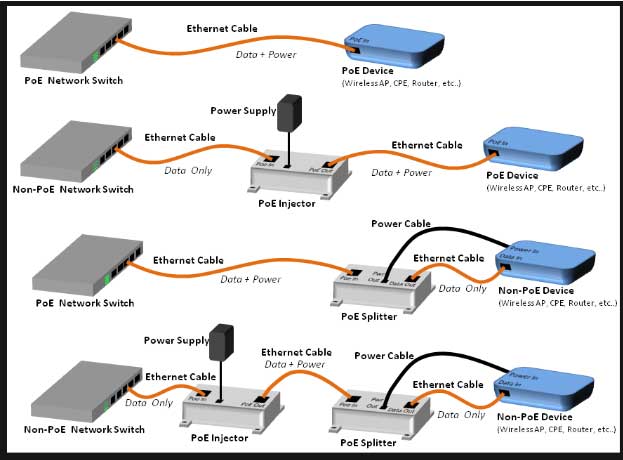How To Setup a PoE Camera PoE stands for power over Ethernet. With PoE cameras both the power and data are supplied by the Ethernet cable. There ar
PoE stands for power over Ethernet. With PoE cameras both the power and data are supplied by the Ethernet cable. There are several different setup methods you can use when setting up a PoE camera. Below is a representation of each method we will discuss in this article:
Using a PoE Swtich
This is the most common and direct method of setting up a PoE camera. To start, run an Ethernet cable from a PoE network switch port to the PoE camera. The PoE network port will provide power and data to the camera.
For more information and documentation pertaining to Amcrest PoE switches, click here
Using a PoE Injector
A PoE injector will be needed only if the switch is a Non-PoE unit. An active PoE injector will supply remote power to the PoE camera via the injector. Most Amcrest PoE injectors provide up to 15.4W of power and are IEEE 802.3af compliant. To start, run an Ethernet cable from the non-PoE network switch to the input port of the injector. This will supply data from the network switch into the injector. Apply the power cable for the injector into the power port and plug the power cable into a power source (wall outlet, surge protector, etc.). Next, run another Ethernet cable from the output Ethernet port of the injector to the PoE camera. This cable will supply data and power to the PoE camera.
For more information or if you would like to purchase a PoE injector, click here.
Using a PoE Splitter
A PoE splitter is used to power non-PoE cameras from a PoE switch. Keep in mind this can only be used if the switch is a PoE unit. A PoE splitter splits the PoE signal into a separate power and Ethernet data source. This allows you to run Ethernet cables from a POE Switch over long distances, and then split the PoE signal into a separate data and power sources to run non-PoE devices.
To start, run an Ethernet cable from the PoE switch to the input port on the splitter. This will supply data and power from the PoE switch to the splitter. Next, plug an Ethernet cable into the input Ethernet port of the non-PoE camera and plug the cable into the output port of the splitter. Lastly, use the connection adapters provided with the splitter to power the non-PoE camera. Most Amcrest PoE splitters can output voltages of 5V, 9V, or 12V.
For more information or if you would like to purchase a PoE splitter, click here
Using a PoE Injector and Splitter
If the network switch and camera are both non-PoE but you would like to have them run as PoE devices you can utilize both a PoE injector and splitter in your setup. To start, run an Ethernet cable from the non-PoE network switch to the input port of the injector. This will supply data from the network switch into the injector. Apply the power cable for the injector into the power port and plug the power cable into a power source (wall outlet, surge protector, etc.). Next, run another Ethernet cable from the output Ethernet port of the injector into the input Ethernet port of the PoE splitter. This will supply data and power to the splitter.
Next, plug an Ethernet cable into the input Ethernet port of the non-PoE device and plug the cable into the output port of the splitter. Lastly, use the connection adapters provided with the splitter to power the non-PoE camera.



COMMENTS
hello nice sharing thanks
Can you write your contact number?
I really love you
It really worked, I appreciate it!
problem not solved thanks
problem not solved thanks
It really worked, I appreciate it!
can you help me please
please provide support for me i leave my email address
I can’t upload
hello nice sharing thanks
I am having trouble with the installation
I can’t upload
Can you write your contact number?
problem not solved thanks
It really worked, I appreciate it!
problem not solved thanks
can you help me please
It was a great sharing
hello nice sharing thanks
Can you write your contact number?
I am having trouble with the installation